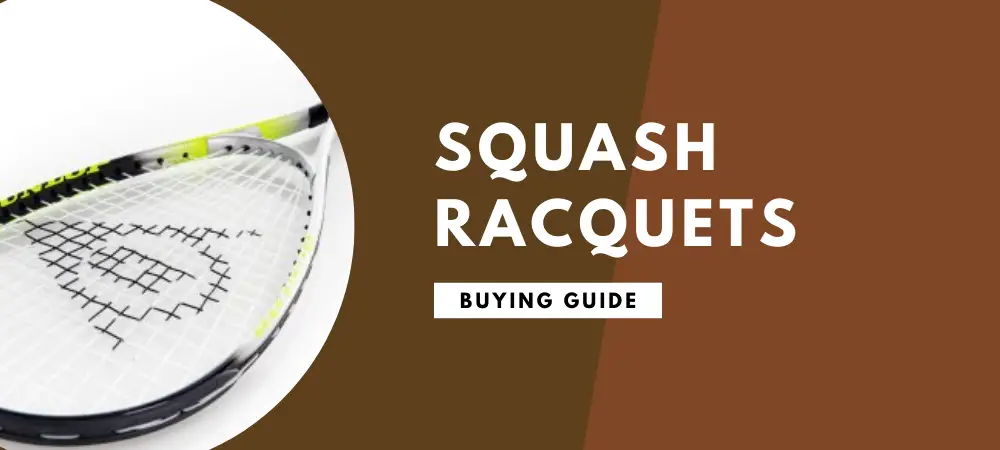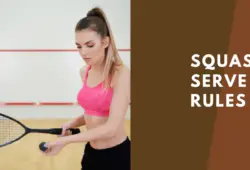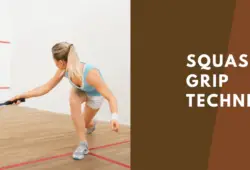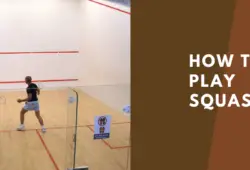When playing squash, a racquet is pretty much an extension of the player’s arm.
The right racquet should enhance your swing as well as help you deliver on power shots.
However, every player’s skill set and style of play is different.
So, what one player is looking for in a racquet might not be what another player needs.
This guide here will help you find the best squash racquet that will suit your style and help you improve your squash skills.
Table of Contents
How Do I Choose The Right Squash Racquet For Me?
Weight
Expect squash racquets to weight between 110g and 190g. This is quite a vast range, so there is a considerable difference between the heavier racquets and the lighter racquets.
First of all, did you know that the weight advertised on the racquets is not their weight as they come?
This is the unstrung weight, often taken before the paint, grip, grommets, and string are added. As a result, the racquet should actually weight more than what’s marked on the racquet frame.
Lighter racquets weighing 130g or less allow for fast movements and more maneuverability. This offers the player a lot more control and touch, a smooth swing, and an enhanced feel.
These racquets have an advantage with delicate drop shots, quick hits, and flicks.
On the downside, lighter racquets lack in power and have poor follow-through, which can result in mishits. Additionally, these racquets have lower durability.
Lighter racquets are preferred by experienced players who have the proper technique required to use the racquet efficiently.
These are a strong wrist snap for follow-through, and a strong forearm for power.
Medium weight racquets weighing between 130-150g are the go-to for most players.
These racquets provide a good balance of power and maneuverability, and they also have better follow-through compared to lighter racquets.
Heavy racquets weighing 150g or more deliver a very powerful swing, stable shots, and a smooth follow-through.
The trade-off here is that these racquets are not easy to control. Some players will temporarily use a heavier racquet to build their wrist power and forearm strength, then change to lighter racquets.
Grip Shape
Squash racquets all come in a standard handle size. The handle shape, however, can change depending on the manufacturer.
Rounded squash racquet handles are comparable to baseball bat handles. This handle shape is comfortable, and the player can readily find an assortment of hand placement positions to get the perfect grip.
The disadvantage is that rounded grip shapes do not provide any hand-to-brain feedback. As a result, the player might need to constantly look down at the racquet to see how the face is aligned.
Additionally, the lack of bevels in rounded handles may result in the racquet twisting during shots, and this would affect the accuracy of the shot.
A rectangular squash racquet handle provides more feedback, and so a player can quickly tell their racquet face alignment without having to look down at the racquet itself.
These also give better hand placement, so you don’t lose your grip easily.
Ultimately, however, it all depends on what feels comfortable in your hands. If you are comfortable, then you can play with confidence and give better performance on the court.
It is possible to modify the grip on a racquet using tape, gauze, and towels. Doing so will allow you to contour the handle shape to your hand better.
Material
Aluminum squash racquets are heavy but very durable. It is almost impossible to damage an aluminum racquet. These racquets are also quite affordable.
The one downside is that because of the highly flexible frame; aluminum racquets generate vibrations when a player hits the ball.
These vibrations reduce a player’s control and could result in unpredictable shots whereby the ball goes in a direction that wasn’t the intended direction.
Graphite composite squash racquets may also be made from materials such as carbon fiber or metal composites, including boron, basalt, graphite, Kevlar, and titanium.
These racquets are much lighter in weight, have a more rigid frame, they are very durable, and they are also quite expensive.
Additionally, vibrations are diffused better in a graphite composite racquet as opposed to in an aluminum racquet.
Wood was the material used in more traditional squash racquets. The disadvantage is that wood was heavy and would be prone to cracking.
Today, wooden racquets are now considered a collector’s item, which you wouldn’t find being used on the court.
Throat Shape
Open throat racquets are the more classic design, and they are quite popular among older players. These racquets give enhanced touch and control, but they lack power.
Additionally, open throat racquets have a string bed that’s smaller and denser, thereby resulting in a smaller sweet spot.
Teardrop racquets are also known as closed throat racquets. In this design, the main strings are longer, and the string bed area is larger, which then results in a larger sweet spot.
Closed throat racquets are very forgiving, and they also offer more power and consistency to your shots. The trade-off here is that you would sacrifice some control.
Hybrid racquets have an elongated teardrop design which allows for the most powerful shots, while at the same time having a more prominent sweet spot that’s more forgiving for off-center shots.
You will, however, notice that these racquets offer less control, so a player would need strong, flexible wrists to compensate for this.
Beam
The beam width of a squash racquet could fall between 16mm and 21mm. The thicker the beam thickness, the stiffer the racquet, and the harder it is to control.
The converse is also true whereby a thinner beam thickness results in a more flexible racquet that’s easier to control.
Balance
A racquet’s weight is not always evenly distributed along the length of the racquet. Some squash racquets weigh heavier at the head, some weigh heavier at the shaft, and others are evenly weighted.
A head-light squash racquet has the majority of its weight placed at the shaft. These racquets offer better control but little power, so they suit players who have established upper body strength.
A head-light racquet would be suitable for flicks and quick volleys.
A head heavy squash racquet has the majority of its weight placed at the head. These racquets offer enhanced power to shots, but the player sacrifices control.
A head-heavy racquet would be suitable for making hard shots with large swings and minimal effort.
An even balance squash racquet has a consistent distributed of weight along the entire length of the racquet.
These racquets offer both power and maneuverability in equal measures, with neither being extreme.
Squash racquet balance is measured in millimeters, indicating the point of balance as measured from the bottom of the racquet.
A head-light racquet feels much lighter while a head heavy racquet feels much heavier. The choice between the two all boils down to a matter of personal preferences though
Strings
-
Type / Material
Natural Gut string is what’s used by most professional players. This string is quite expensive, but it plays the best and gives a superior feel of the ball.
Synthetic Gut string, also known as a multifilament string, is a popular choice, and this is what comes in many factory strung racquets. The string plays well and is more durable than natural gut string.
Monofilament Nylon string is very tough, and it is ideal for the players who tend to break their racquet strings regularly.
Because of its high strength, this string offers less feel and comfort. To enhance its play, you will often find the monofilament string being used as the main string with synthetic gut running across it.
-
Gauge
Thinner 18-gauge strings are capable of stretching further. As a result, they give more power, but the trade-off is that they are less durable.
Thicker 17-gauge strings are more durable, but they also have less stretch. As a result, you get a better feel of the ball as well as enhanced control.
-
Tension
The average string tension is about 28 PSI, and most squash racquets come factory strung at about 26-28 PSI.
A higher tension results in more touch and control, while a lower tension gives more power to shots.
-
Grommet Holes
These are the holes through which the racquet strings are threaded. Larger holes allow for the string to move more freely, thereby increasing the size of the sweet spot.
-
Pattern
More strings translate into more power and a larger sweet spot, therefore, a more forgiving racquet.
Fewer strings give a smaller sweet spot, therefore, increasing the chances of mishits and, likewise, increasing the likelihood of string breakage as well.
14 x 18 is the standard string pattern for most open throat racquets. This close string pattern gives more grip and spin on the ball. Other good string patterns include 16 x 17, 18 x 17, and 16 x 16.
Price
How much are you willing to pay?
Always keep in mind that price does not necessarily mean quality. The price point of a racquet should be guided by the factors mentioned above.
Consider the material and performance of the racquet before looking at its price.
You can find a great durable racquet for very cheap, and you can spend $150 on a racquet only to have it break in a couple of weeks.
A good beginner racquet shouldn’t cost you more than $100. And a good racquet for an intermediate player should cost between $100 and $150. Premium racquets may cost well over $200.
Best Squash Racquets In 2021 For Beginners
This racquet makes use of MicroGel™ Technology to construct the frame. This silicone-based material combines MicroGel™ with tough carbon composite fibers.
The combination of materials creates a racquet with incredible responsiveness. The MicroGel™ design provides a superior touch with every shot and a rock-solid feel.
Additionally, this construction technology helps diffuse the vibrations when a player hits the ball.
All vibrations get uniformly distributed around the frame, then they are channeled down the racquet and out through the handle.
The head gives zero feedback, thereby allowing for more accurate and predictable shots. As a result, the racquet enhances control of the head-light racquet while allowing for easy swings.
Mastering control of the racquet is an essential skill for a beginner player, and that’s just what this racquet guarantees.
The teardrop design gives a large string bed area of 500cm2, which results in a large sweet spot.
Players will find that this racquet is very forgiving, thereby allowing for accuracy even when you hit balls off-center.
- Features vibration reduction.
- Offers superior control.
- Has an excellent grip.
- Has a large sweet spot.
- Enhances touch, feel, and accuracy.
- Factory strings might need to be replaced with higher quality ones.
The HEAD Extreme 120 squash rachet features Innegra™ Technology used to construct the frame of the racquet.
This technology integrates a hybrid-composite structure into the racquet for improved stability as well as shock absorption properties.
The result is reduced vibrations on ball impact. Reduced vibrations additionally enhance the accuracy of shots and give the player unique control of the racquet.
Regardless of the force of the ball impact, the player would be adequately protected.
With a frame weight of 120g, this racquet is incredibly lightweight. However, the Innegra™ frame technology makes it tough as well, thereby resulting in a lightweight racquet that is surprisingly durable.
At the same time, this racquet has been designed to be head heavy, thereby giving power to shots without the player needing to put in too much effort.
The teardrop design gives the string bed a sizeable sweet spot ideal for beginners.
- Lightweight frame.
- Has advanced shock absorption.
- It is made from very tough materials.
- Offers superior control and precision.
- Head heavy for powerful shots.
- It doesn’t come with a protective cover.
The Karakal SN-90 FF squash racquet has an unstrung weight of 90g, which makes it among the lightest squash racquets in the market.
At the same time, though, you will find that this racquet is surprisingly robust and sturdy.
This racquet is constructed from fast fiber carbon gel, which is low in density but high in strength.
These properties help to regulate the stiffness of the racquet frame.
This racquet can regain shape 10% faster than conventional racquets made from graphite composites.
As a result, what the player gets is a squash racquet, which produces a lot of power with minimal effort and very little torque as well.
This way, you can make shots that are straighter, more accurate, flatter, and more controlled.
- Extremely lightweight.
- Head heavy for more power.
- Ideal for drop shots and lobs.
- Has reduced torque.
- It comes with a full racquet cover.
- It might take time getting used to the super lightweight racquet.
It’s not every day you see a beginner squash racquet, which guarantees power, durability, and precision, but that’s exactly what the HEAD Nano TI 110 squash racquet brings to the table.
To begin with, this high-quality racquet is constructed from nano titanium/carbon.
This combination provides optimum weight reduction on the frame combined with stiffness and strength so that the racquet does not crack easily.
Additionally, the lightweight construction gives this racquet a frame weight of 110g, which is pretty light.
This allows for easy maneuverability while using the racquet and allows the beginner player to work on their control as well.
With a balance of 360mm, keep in mind that the racquet is designed to be head heavy, therefore giving power to shots. Power is further enhanced by the enlarged grommets positioned at 3 and 9 o’clock.
These enlarged grommets not only result in more power, but they also increase the sweet spot of the string bed, therefore, making the racquet very forgiving.
- Tough yet lightweight.
- Head heavy design enhances power.
- Strung with superior quality Synthetic Gut.
- It comes with a full protective cover.
- It is very forgiving.
- Head heavy design makes the racquet feel much heavier than it actually weighs.
Most beginner racquets are lightweight racquets weighing below 140g.
In case a beginner desires something slightly heavier, however, then the Head Spark Tour squash racquet would be an ideal choice.
This racquet has a weight frame of 160g, which makes it suitable for the beginner player who is all about power shots.
Additionally, the heavier weight allows it to deliver a smooth follow-through on shots.
At the same time, this racquet is evenly balanced, so the weight is distributed uniformly along the entire length of the 68.5cm long racquet.
The even balance allows for a great balance of power and maneuverability, thereby giving the beginner player the best of both worlds.
The racquet has been constructed using HEAD’s Amplified Fiber Technology (AFT), and it comes in a teardrop throat design. AFT enhances the stiffness of the racquet, thereby optimizing power.
- Has an excellent grip.
- Delivers optimum power.
- Provides a perfect combination of power and feel.
- It has a large sweet spot.
- It comes with a 1-year warranty.
- It might be too heavy for most beginners.
Top Squash Racquets In 2021 For Intermediate and Advanced Players
The Harrow Vapor is a top-rated squash racquet and for a good reason too.
This racquet delivers a perfect combination of power, responsiveness, and control, which is just what every serious player wants on the court.
This racquet has been strung using Barrage Pro, which is a synthetic braided multifilament string.
This 18-gauge string has impressive durability and plays incredibly well.
So, you get a good grip for greater ball spin, control, and power.
With a balance of 380mm, this racquet is evenly balanced for equal delivery of power and control of shots.
At the same time, the frame is pleasantly lightweight, weighing 140g when strung and made from hardened carbon graphite.
- It gives a nice balance of power and control.
- Has a very responsive feel.
- Very lightweight yet stiff.
- It has no vibration.
- It offers excellent value for money.
- It is quite pricy.
One striking feature of the Harrow M-140 is the larger head size.
The larger head allows for a larger sweet spot, therefore, making the racquet more forgiving when the player makes off-center hits.
For this reason, this would be a great racquet to use when playing doubles.
The evenly balanced 380mm racquet has an unstrung weight of 145g, which falls in the range of medium-weight racquets.
This squash racquet is not only easy to control, but it also delivers excellent power, thereby imparting a decent velocity on the ball upon contact.
With a factory string tension of 28 PSI, this racquet enhances the touch and feel of the ball, allowing players to have a better swing.
This has also been made possible by the superior PU grip on the racquet.
- Lightweight design.
- Perfect racquet for doubles plays.
- It has a large sweet spot.
- Provides great touch and control.
- It has a stiff and durable frame.
- It doesn’t come with a protective cover.
The Black Knight Ion Cannon PS PowerSurge squash racquet is designed to deliver powerful shots, and the racquet does not disappoint.
It has a frame weight of 135g and an even balance. Additionally, the Power Surge technology utilized in the frame of the racquet drives power towards the head during a shot.
At the same time, this Power Surge design reduces vibrations and stiffens the shaft, thereby reducing its flex.
BK’s Thermal Core Technology has been applied to the frame.
This gives uniform curing during construction, thereby enhancing the durability of the frame as well as improving its responsiveness.
The teardrop throat shape comes string with Ashaway Supernick ZX string, which has excellent playability, improved durability, and better tension retention.
The 17-gauge string is on the thicker end of squash racquet strings, so it gives a better feel of the ball.
- Factory strung using superior quality Ashaway string.
- Offers enhanced ball feel and touch.
- Very durable.
- Rectangular grip shape offers better hand placement.
- It has no vibrations.
- The small sweet spot isn’t very forgiving.
The Tecnifibre Carboflex (S) squash racquet is available in a variety of weights, namely 125g, 130g, and 135g.
All the weights are pretty lightweight, which makes this racquet perfect for attacking players who prefer an aggressive style of play and making long volleys.
The unique isomorph shaft is one unique feature, as opposed to other shafts having a standard mono shaft.
The isomorph shaft on this racquet gives a stiffer feel, thereby offering increased power.
This racquet boasts of a string sweet spot, so more experienced players can play with precision and control as long as they can consistently make contact with it.
At the same time, the head-light balance allows for speed and maneuverability.
- Factory strung using Synthetic Gut.
- Head-light balance offers speed.
- 29 PSI string tension offers better touch and control.
- Lightweight and maneuverable.
- It comes with a cover.
- It has slightly more vibrations compared to other racquets in this caliber.
The HEAD Graphene XT Cyano 110 is an affordably priced premium squash racquet guaranteed to elevate your game to the next level.
This racquet makes use of HEAD’S new Graphene XT Technology, which makes the racquet lightweight for enhanced control and maneuverability but without sacrificing power.
Thanks to this advanced technology, the Graphene XT used to construct the racquet has unrivaled strength.
No matter how many times you accidentally hit the wall, there’s no chance you would ever break this racquet.
This advanced technology also allows for proper distribution of weight along the length of the head-heavy racquet, but this isn’t done like in standard racquets.
The HEAD Graphene Cyano 110 adds weight to the top and bottom of the racquet.
As a result, players generate more kinetic energy when striking the ball, thereby creating more power, all the while using less weight and effort.
- Lightweight but stiff with a 20mm beam.
- Has an impressive strength to weight ratio.
- Head heavy for power.
- Features unique weighting.
- It has no vibrations.
- You might want to regrip for a better grasp of the racquet.
The Tecnifibre Carboflex 125 X-Speed squash racquet has a clean, sleek look, and it plays as great as it looks.
This racquet allows for fast play, power, and it is very forgiving as well.
The AeroShaft design included in this squash enhances the player’s control and also results in a better feel when it comes in contact with the ball.
Additionally, iBlades have been introduced along the shaft of the racquet, and these provide a bit more stability and rigidity to limit flexibility.
As a result, the Tecnifibre Carboflex 125 X-Speed feels more solid upon contact with the ball.
With a balance of 350mm, this head-light racquet allows for more speed and aggressiveness on the court.
- It allows for high-speed play.
- Offers superior touch and feel.
- Head-light design allows for better control.
- It comes with a high-quality factory string.
- It has an excellent grip.
- It has some slight vibration.
The teardrop design of this racquet comes with Vibra Plate technology.
This technology stiffens the head of the racquet, thereby reducing torsion when it comes in contact with the ball.
It additionally helps with diffusion of vibrations for shock-free hits that feel exceptionally solid.
Better yet, the bubble shaft on the racquet offers a better flex response.
Besides enhancing the touch and feel of the ball, this enhanced flex response also aids with the absorption of vibrations.
The rad cushion grip is another feature that provides non-slip control of the racquet.
Whether you are using the racquet in wet or dry conditions, the grip on this racquet holds up exceptionally well.
- Factory string with high-quality Ashaway strings.
- Has an excellent grip.
- It has no vibrations.
- It has high durability.
- Provides a superior combination of power and control.
- Not ideal for doubles play.




